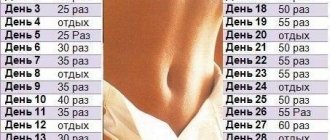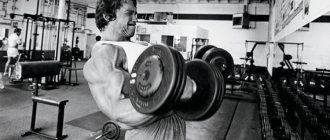Training principles
10 sets of 10 reps
German volume training involves the athlete performing 10 sets of 10 repetitions per exercise, thereby performing about 100 heavy repetitions. In addition, the weight of the apparatus (barbell or dumbbells) should be the same from the first to the last approach. In order for you to be able to sustain all 10 sets, the weight must be appropriate from the very beginning. For example, let's say you're going to do a barbell bench press. In this case, set the weight with which you reach failure around 20 repetitions. Or, if you know your 1RM (a one-rep max—a weight you can only do one rep with), then load the bar at 60% of your 1RM. After completing the approach, the rest time should be about 60-90 seconds.
Exercise pace
An important condition is also the pace of the exercises. The movement of the projectile during the exercise is divided into 3 phases - concentric, peak contraction and eccentric. Let's take the same bench press as an example. The trajectory of the barbell from the top position to touching the chest is the eccentric phase of the movement, from the chest back up is the concentric phase, in the top position is the peak contraction. Returning to the pace of the exercises, it should be noted that the eccentric phase should be slow (3-4 seconds), that is, lower the barbell to the chest slowly. After touching her chest, you need to squeeze it up twice as fast. The same will apply to other exercises. For example, when doing squats, you first lower yourself with the barbell for four seconds, and then get up in two.
How to run correctly
Rest between sets is 15 seconds, between exercises - 30 seconds. The exercises are the same as on Monday.
The standards for the 3*10 m shuttle run for schoolchildren are developed depending on age (7-17 years), gender and level of training (high, medium, low). Raising arms and legs while sitting.
The athlete sits on the floor, stretches his arms in front of him and raises his legs. At this moment, the legs should be spread, and the arms, on the contrary, should be brought together.
Shuttle running allows you to train in the gym in unfavorable weather, because... For this exercise you need a small area with markings for the beginning and end of intermediate distances. If we consider a shuttle, where there are 5-10 m between the markers, then you can certainly run 5 markers there without stopping.
How to train shuttle running?
This year I was able to run fully and, trying my best, ran in 25 seconds (my record is 24 seconds). A few days later I decided to try walking like I did a year ago. I showed the same time!!! As a single remedy, she is also advised to run 4:70 for small volumes (6-10 km/day).
Speed endurance
The initial start is most often used high with support on one hand, but other start options are also allowed. After passing each intermediate distance in the opposite direction, at the start the technique of braking and subsequent acceleration is used.
Sprint with change of direction
Turns require mastering a stopping step; this step, in addition to shuttle running, is most often used in basketball. The shuttle running standards of 10*10 and 4*9 m were developed for military personnel and boys in grades 9-11.
At its core, this is short-distance running, only the number of races in one cycle is more than one.
The athlete runs a short section of the path once, turns around, runs back along the same route, repeats the exercise, etc.
Attention!
With the help of such exercises, athletes train to accelerate quickly, start and finish on time. It is also suitable as a warm-up exercise to improve speed in sprinters.
It is necessary to start the lesson, as in the standard complex, from the starting position. It can be either low or high. Special foot rests are not used in shuttle running. And it is better to refrain from the finishing jump; today even professional sprinters have become convinced of the low effectiveness of this technique.
During the game, hockey players need to be able to quickly develop and slow down speed over a period that lasts only 30-45 seconds. S.E. Pavlov: An athlete’s training should be based on reference to energy supply modes, the increase in power and capacity of which constitutes a resource for the development of sports.
It is this complex that is trained in the process of performing certain work. It is also not clear that many coaches often chase gigantism in players, giving preference to players who may be big but have problems with coordination, speed, and endurance.
This will make it possible to track and compare the results obtained. The distance increases from 1 km to 3 km. The running pace is slightly above average; by the end of the cycle it should be brought to 70-80% of the maximum. Table 1. In this case, the hand is always raised behind the supporting hand, and the legs remain in place. The exercise is performed clockwise and counterclockwise.
You love games with team running and have long guessed that you can run fast in different ways, but did not know how to comprehensively develop your speed qualities
After push-ups, without rest, the athlete walks on his hands along the entire length of the bars in one direction and the other. The number of approaches depends on the player’s level of training. In principle, these are all simple exercises that do not require the use of any complex machines or barbells. But the use of these exercises helps to develop the strength and power of the athlete.
Running with a partner. For 60 seconds, the running is carried out at a low pace; on command, the players start sharply and run at a high pace for 15 seconds. Then run again at a low pace. This is repeated 10 times. On Tuesday and Friday we work on the complexes. The player is constantly in motion, but at the same time he performs various strength work.
Complex 1. This exercise is performed at a distance of 25-30 meters. 10 repetitions are performed in one approach. Jumping with a partner. On Mondays and Thursdays, all exercises related to fast running. The speed of the exercise should be close to maximum.
The exercises are performed in 3 approaches, the first two approaches are done with weights, and the last approach without them. The “start” command is given with a wave of the hand and voice. The player starts from different positions: low start, prone position and low start with his back to the distance. Running with turns. The exercise is performed for 40 seconds. Running sideways. At a distance of 60 meters, racks are installed in a checkerboard pattern.
But the question immediately arises: to run or not to run short accelerations?
The player stands inside this “cross” and begins to run quickly in place, then jumps over the ball, takes several steps and jumps back to the starting position. After a few steps inside the figure, he jumps over another ball. The exercise is performed for 15 seconds. It is considered that the speed is there or not. This is an excuse not to work.
Movements are performed in one direction and the other. “Break”. The athlete, while jumping, pulls the foot of his left leg towards his right knee and slams his palm on it.
Torsion is performed forward and backward. Hyperextension with gripping the legs with the hands. In this position, he tries to bend even more and holds his legs for 20 seconds. Hyperextension with rotation.
Important!
The athlete takes the position as in the previous exercises. This is one approach. In principle, physically the player is in good shape.
Considering that the training was carried out only with his own body weight, his muscles are not clogged, they are strong and elastic.
On the subject: How to increase endurance and running speed
The athlete stands with his back to the distance, puts his foot on the ball and begins to move. At the same time, he jumps on the supporting leg, and with the other leg, which is on the ball, he rolls it behind him. When returning back, the ball is dribbled with the other foot. Work with soccer and basketball balls.
The player begins lateral movements from post to post while dribbling the ball. The return is carried out backwards. Dribbling and throwing. He starts dribbling, on command he turns around in a jump and makes a throw into the hoop.
If the guarding player forces the ball to be lost, then he must pick it up and throw into the hoop. Throwing the ball for American football.
Not only is the player constantly in motion, he is under forceful pressure, he plays on skates and holds a stick in his hands.
In this case, it is recommended to play one on one, one against two, and the so-called “sun” (several players stand around the perimeter of the table and start running around it, hitting the ball).
At work, we periodically take physical exams. standards, and in the cold season it includes a shuttle run of 10 by 10m. A year ago I had a back injury and could not fully run. To understand how to run shuttle running, you need to focus, first of all, on your speed limit. It should be maximum, because this is precisely what this complex was developed for.
Source: https://folkasernover.ru/kak-pravilno-begat/
Choose multi-joint exercises
It should be remembered that when creating your own training program according to the principles of NOT, not every exercise may be suitable. For 10 sets of 10 reps, you should choose multi-joint movements rather than isolation movements. For example, for training legs, the best option would be squats, but not leg extensions in a machine, or for triceps it would definitely be better to do a bench press with a narrow arm position than extensions with a dumbbell or in a crossover.
Also, there should be one exercise for one muscle group, since the volume of the load is already very large. This is another reason to choose multi-joint exercises that work many muscle fibers.
To work additional muscle groups, you can add three sets of 10-12 repetitions per exercise to your split (we also choose one per muscle group). I will give an example of a training split at the end of this article.
When performing German volume training, forget about any intensification techniques. The amount of work that your muscles will do is already very large, and it is more than enough for good hypertrophy. Aim for 10 sets of 10 reps with one weight. When you can do this, increase the weight by about 5% and try to complete the workout with it.
Positive features of German volume training
Speaking seriously, one cannot fail to note the positive features of German volumetric training, which make it one of the most effective training systems. Here they are:
The nervous system gets the rest it needs, the time the muscles are under load increases, which enhances the “hormonal response”, and the total tonnage that you “turn over” during the workout increases.
But, alas, there is no escape from the gloom of the system. Especially if you work two muscle groups in one workout.
What if you stop at just one? True, in this case you will have to visit the gym more often. But... Perhaps the created “marafet” will allow us to hide the external unsightliness of our “German”?
Workout plan
This program is built on the principle of supersets (exercises performed without rest, one after another) for antagonist muscles, that is, located parallel to each other and performing actions opposite in direction. For example, biceps and triceps, which are needed for flexion and extension of the arm, respectively. Exercise tempo: 4 and 3 seconds for the eccentric phase and 2 for the concentric phase, for supersets 10x10 and 3x10-12, respectively. It should be performed for 6 weeks.
Read on to see what a weekly split will look like.
Monday – chest and back
- Superset: bench press + pull-ups on the horizontal bar with a wide grip; 10 sets of 10 reps, resting no more than 90 seconds between supersets.
- Superset: lying dumbbell fly + seated horizontal block row to the waist; 3 sets of 10-12 reps, rest between supersets no more than 60 seconds
Tuesday – legs and abs
- Superset: squats with a barbell + lying down curls in the machine; 10 sets of 10 reps, resting no more than 90 seconds between supersets.
- Superset: Lying crunches + seated calf raises; 3 sets of 15-20 repetitions, rest between supersets no more than 60 seconds
Wednesday – rest
Thursday – biceps, triceps and shoulders
- Superset: dips (for triceps) + dumbbell curls for biceps; 10 sets of 10 reps, no more than 90 seconds rest between supersets
- Superset: dumbbell lateral raises + bent over dumbbell lateral raises; 3 sets of 10-12 reps, rest between supersets no more than 60 seconds
Friday - rest
After 6 weeks of this program, you should change the exercises to others, but using the same muscle groups. You also need to change the number of repetitions in 10 sets, that is, now you will not do 10 sets of 10 repetitions, but 6 repetitions. For example, for the first day, the bench press can be replaced with a barbell press on an inclined bench, and pull-ups on a horizontal bar with a vertical block row to the chest. This version of the program can be used until a plateau occurs in strength or mass gain.










